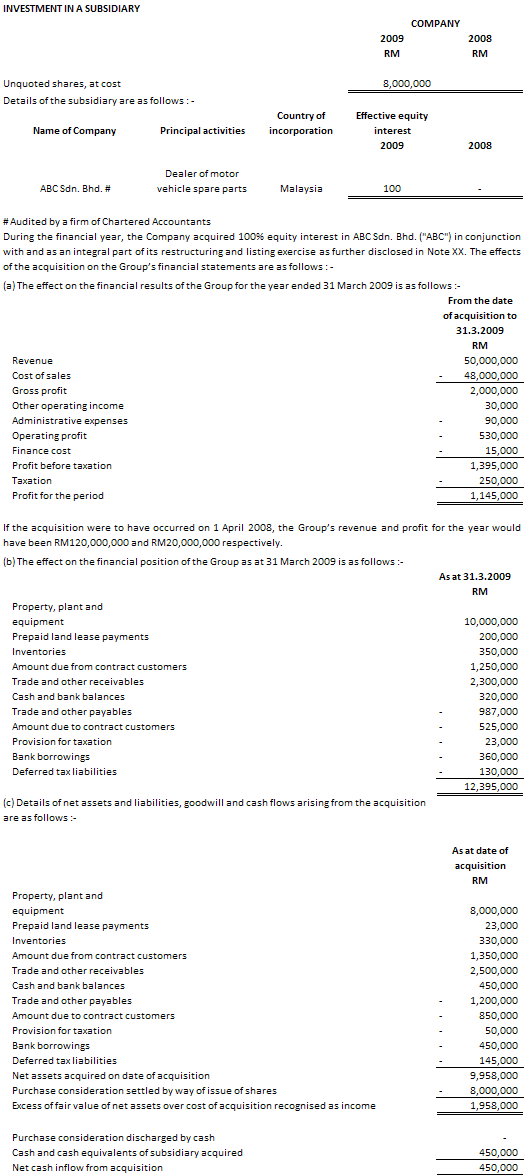Tag: Sample Disclosure in Financial Statements
Sample Disclosure – Note On Earnings Per Share (29 September 2009)
EARNINGS PER SHARE
(a) Basic
The basic earnings per share is calculated on the Group profit for the financial year attributable to equity holders of the Company of RMX,XXX,XXX and is based on the weighted number of ordinary shares outstanding during the financial year of XX,XXX,XXX.
(b) Diluted
Diluted earnings per share is not presented as there are no dilutive potential ordinary shares outstanding as at 31 March 2009.
Sample Disclosure – Note On Goodwill (27 September 2009)
INTANGIBLE ASSET – GOODWILL
Click Here For File In Excel Format
For the purpose of impairment testing, goodwill is allocated to the subsidiary which represents the lowest level within the Group at which the goodwill is monitored for internal management purpose.
During the financial year, the Group has recognised impairment loss on goodwill on consolidation of RM30,000 (2008 – Nil) due to the deterioration of the financial position and financial performance of a subsidiary in property development segment.
The balance of the goodwill on consolidation of RM500,000 (2008 – RM530,000) is related to the manufacturing segment and the recoverable amount is determined based on the value-in-use calculations. The calculations performed are based on the pre-tax cash flow projections derived from financial budgets approved by the Directors covering the coming 5 financial years. This method of calculations is consistent with that adopted in the previous financial year. The key assumptions used in the calculations are as follows:-
(a) Sales growth rate of 10% for the first two financial years from the 2010 budget, which is the base year for the cash flows projections, and 12% for the subsequent financial years.
(b) Discount rate of 10%, being the estimated weighted average cost of capital of the Company.
(c) Terminal value representing the projected carrying amount of the net assets of the manufacturing segment as at the end of Year 5.
The Directors determined budgeted gross margin and results based on past performance and its expectations of market development. The discount rate used are pre-tax and reflect specific risks relating to the relevant segments. Based on the recoverable amount determined, goodwill on consolidation related to the manufacturing segment is not impaired for the current financial year. With regard to the assessment of value in use, the Directors believe that no reasonably possible change in any of the above key assumptions would cause the carrying value of the unit to be materially different from its recoverable amount.
Sample Disclosure – Note On Property Development Costs (17 September 2009)
Sample Disclosure – Note On Land Held For Development (16 September 2009)
LAND HELD FOR DEVELOPMENT

Land held for development of certain subsidiary companies are charged together with property development costs for banking facilities granted as disclosed in Note XX.
Sample Disclosure – Accounting Policy On Construction Contracts (15 Septemeber 2009)
Construction Contracts
Where the outcome of a construction contract can be estimated reliably, revenue and costs are recognised by reference to the stage of completion of the contract activity at the balance sheet date, measured as the physical proportion that contract costs incurred for work performed to date bear to the estimated total contract costs, except where this would not be representative of the stage of completion. Variations in contract work, claims and incentive payments are included to the extent that they have been agreed with the customer.
Where the outcome of a construction contract cannot be estimated reliably, contract revenue is recognised to the extent of contract costs incurred that it is probable will be recoverable. Contract costs are recognised as expenses in the period in which they are incurred.
When it is probable that total contract costs will exceed total contract revenue, the expected loss is recognised as an expense immediately as allowance for foreseeable loss.
When costs incurred on construction contracts plus recognised profits (less recognised losses) exceeds billings to contract customers, the balance is shown as amount due from contract customers. When billings to contract customers exceed costs incurred plus recognised profits (less recognised losses), the balance is shown as amount due to contract customers.



